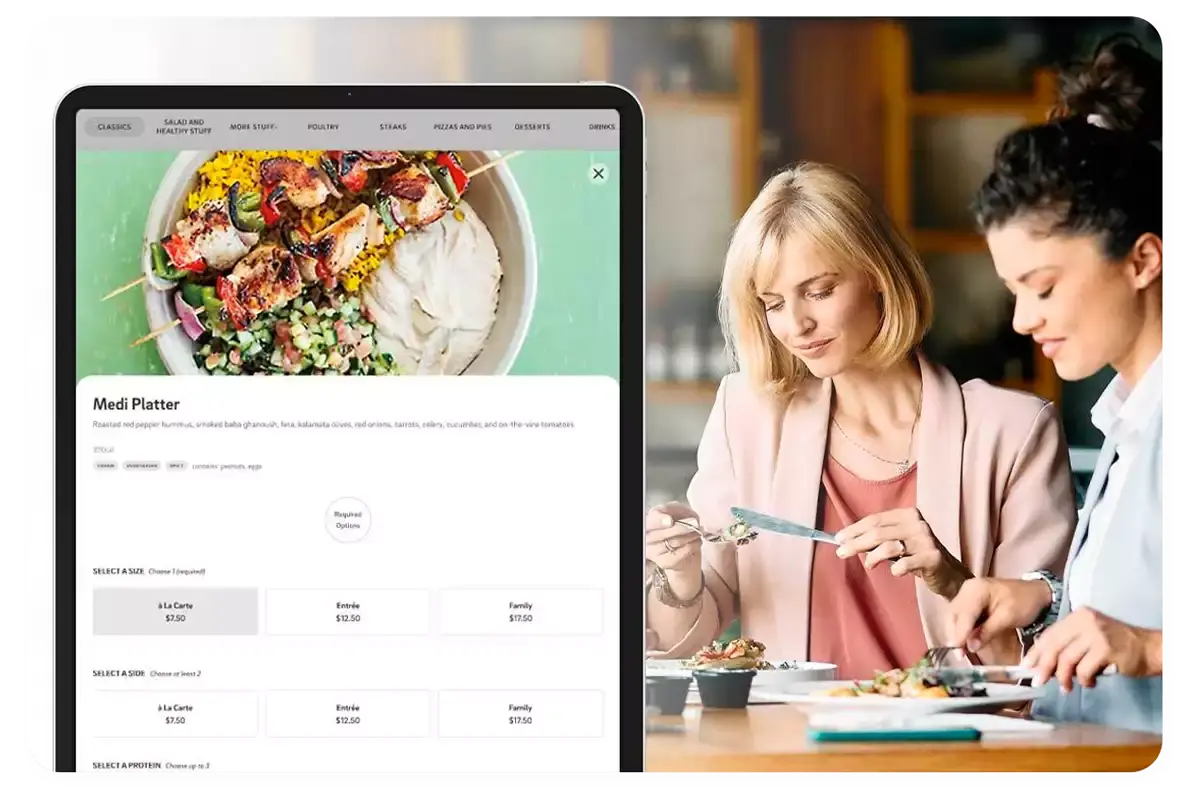In today’s fast-paced world where convenience is king and customer experience reigns supreme, restaurants are switching up their service game. Welcome the simplicity and efficiency of tableside ordering services.
In this blog, we will share the advantages of using a tableside ordering system that can elevate your establishment from good to delicious. Whether you’re a small bistro or bustling eatery, we’ve got the scoop on how going digital at the dinner table can spice up your service, satisfy your patrons, and cook up some serious profits.
What is tableside ordering?
Tableside ordering is a system that allows customers to see menus, place orders, and make payments through the use of their own devices, using a tabletop kiosk or through a server using a tablet.
The value in tableside ordering is providing a better customer experience while increasing speed of service and faster table turns.
There are several forms of tableside ordering where the ordering method has the same result. All orders go from a digital device and directly to the kitchen.
Mobile POS: Handheld POS devices can be carried anywhere in a restaurant, which reduces the need for servers to make constant trips to and from anchored central POS stations.
Kiosks: Kiosks allow customers to order and pay at the device. Self-service kiosks include descriptions of menu items so customers can customize their order how they would like.
QR code ordering: QR code ordering allows customers to use their own devices. Once scanned, the restaurant’s online menu populates and enables customers to order and pay on their device.
Restaurant benefits of tableside ordering
1. Increased speed of service and table turns
The advantage of tableside ordering means customers don’t have to wait to order and can speed up the checkout process with contactless payment options.
For example, tableside ordering through QR codes or kiosks, customers can look at the menu when they sit down and punch in their drink and food orders without seeing the server.
In both cases, orders are sent directly to the kitchen. That alone could save almost 10 minutes.
The benefit for the restaurant owner is it allows servers to increase their efficiency and handle more tables, yielding better tips for them.
With a mobile tableside ordering system, servers no longer have to take multiple tables orders at once and then input them into the POS all at the same time. This can cause back up in the kitchen and leaves more room for order errors which can impact the dining experience negatively.
2. Increased order accuracy
With tableside ordering, a server is fully engaged with customers meaning there’s less chance of having an incorrect order.
In addition, the server isn’t taking a customer’s order, then going to another table to take another order before putting them into a central POS, where the server can make a mistake.
With a mobile tableside ordering system, the server is right there with the customer. The order goes in at the table and is sent to the kitchen.
To take a further step in efficiency, QR code ordering empowers customers to order and pay on their own devices, saving staff even more time to handle other duties. Whether an order is sent from a server’s mobile device or from a guest’s phone, it goes directly to the kitchen and creates and open ticket to keep the customer and server in sync.
Increased order accuracy makes the lives of the server and kitchen staff easier. It can also help restaurants save on food costs and waste.
3. Improved security
There is several advantages for customers who pay on their own device. As a restaurant owner, you should take the opportunity to provide the guest with as many options as you can.
Payment options like ApplePay and GooglePay give the customer a contactless payment method. There’s added security since the customer’s payment card number isn’t exposed to anyone.
Paying at the table through the server’s mobile POS solution is another option where the customer gets insurance of a safe transaction since everything is processed in front of them.
Restaurant patrons are concerned about credit card fraud, and it’s easy to fall victim at eateries. When diners hand over their card, they don’t see where their card goes and what’s done with it. Tableside ordering and payment mean customers’ cards are always in their hands, so they feel confident in the security involved in paying for their meal.
4. Improved server knowledge
A tablet provides everything your server needs to know about menu modifications, automating pricing, payments, and inventory.
Servers can look at their mobile device if a customer questions an ingredient they don’t like or are allergic to a particular item. There’s no running back to the kitchen to ask the chef what’s in a dish.
Staff members can let guests know about daily specials and promotions or upsell an item efficiently at the table.
5. Show customers restaurants can evolve
Evolving as time goes by doesn’t mean a restaurant loses its specific charm or soul, simply that it’s finding new ways to enhance current business aspects and processes.
Customers like seeing eateries keeping pace with new norms and emerging technology. About 65% of customers say they would visit a restaurant more often if self-service kiosks were offered and 70% of consumers prefer using self-ordering technology.
Changing to keep up with the time’s lets clients know the restaurant is current, flexible, and open to change.
6. Better tips, better reviews
With better engagement, order accuracy, and speed of service, servers will notice they will be getting better tips due to an elevated service. In addition, tableside ordering enables servers to handle more tables, generating more tips for each shift.
Once customers get to experience this digital shift of tableside ordering, they may be more likely to share their great experience with online reviews through sites like Google and Yelp. According to a Harvard Business School survey, an increase by one-star on Yelp shows a 5-9% increase in revenue.

Delight customers with tableside ordering
It’s vital for a restaurant owner to keep customers happy because delighted customers return more often, replace with other people, and advocate for the brand to others.
Tableside kiosks can be as customizable as the restaurant makes it, which empowers guests to customize their order improving the overall customer experience.
Guests don’t need to wave down a server or ask about the daily specials. They can simply use the tableside ordering services and do what they please at their own pace.
With a mobile tablet solution, customers have a direct connection with the server and a better satisfaction that their order will be correct and accurate since the server is sending the order to the kitchen right in front of the customer.
Most importantly, customers will enjoy an improved dining experience. Customers can expect faster ordering, delivery, and checkout. Along with more accurate orders, a greater sense of security when paying, and an overall smooth and efficient process.
Conclusion
Tableside ordering can help restaurants streamline operations, support staff, improve customer experiences, and revolutionize the process of dining. By revolutionizing the dining process, CAKE’s tableside ordering system brings a new level of convenience and satisfaction to customers, making it a valuable addition to any eatery seeking to stay ahead in the industry.
What kind of tableside ordering does your restaurant offer?







